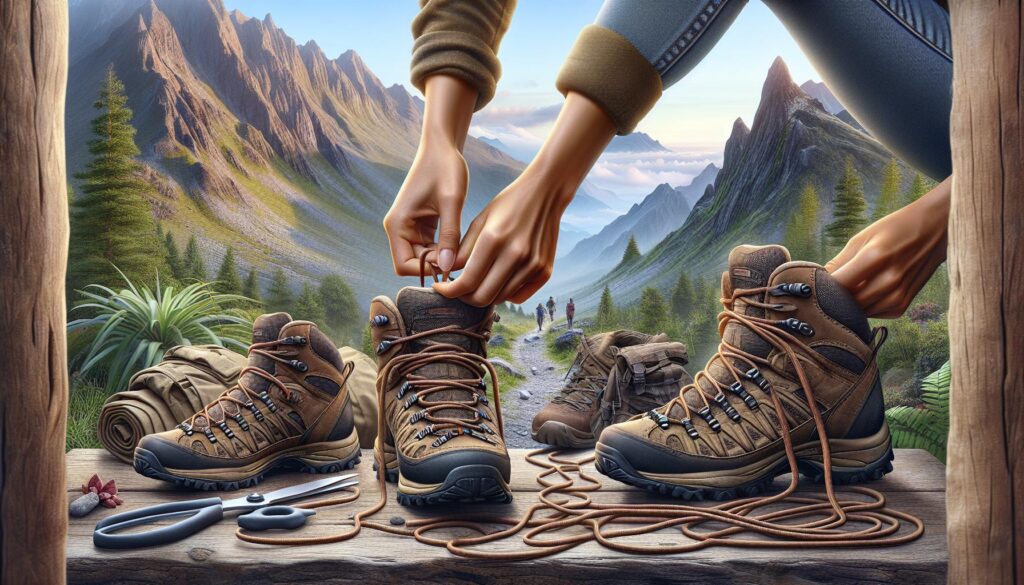Table of Contents
Secure Your Strides: A Comprehensive Guide to Hiking Boot Lacing
Preventing heel slippage in hiking boots is as simple as tying them the right way. Thorough boot lacing can guarantee a secure fit, ultimately keeping blisters and discomfort at bay. Embrace your hiking escapades with a steadfast grip that only ingenious lacing techniques can offer.
Undoubtedly, hiking serves as a bridge between us and the great outdoors, offering experiences that are both liberating and soulful. Yet, the joy of exploration can be hindered by pesky problems such as heel slippage in improperly sized boots. Imagine traversing treacherous terrains with your heels relentlessly sliding within your boots – discomfort, instability, and safety issues are inevitable.
Fortunately, you can effectively curb this challenge by mastering the art of how to tie hiking boots to prevent heel slippage. We present an in-depth guide that unveils efficient lacing techniques designed to secure your boots and grant a snug fit. Join us and learn how to hold your heels steadfastly positioned on your next hiking expedition.
1. Nailing the Basics: Understanding Hiking Boots
A foundation of tackling heel slippage lies in ensuring your boots fit right. An ideal fit provides critical support and ensures stability whilst preventing your feet from moving within the boots. Heel slippage can engender discomfort, blisters, and possible mishaps on the trail.
The solution begins with choosing correctly-sized hiking boots. Consider visiting outdoor specialist stores where staff can help identify a perfect fit according to your foot measurements. Bear in mind that different brands offer various sizes and fits: always try various suitable options before finalizing your purchase.
The width of your boots also matters - your feet need sufficient room to spread naturally without feeling restricted. And if your feet are either narrow or wide, ensure the boots cater to these specific needs.
A significant contributor to reducing heel slippage would be a strategic lacing technique. Initially, loosen the laces completely and gradually tighten from the bottom upwards. This method guarantees a snug fit around your foot, offering optimum support while minimizing movement. Explore and experiment with different lacing patterns and find the one that suits you the most.
2. Discovering the Right Hiking Boots
Choosing hiking boots involves a detailed analysis of several elements to certify a perfect fit and size. Considering these following factors can help you make an informed decision.
| Essential Elements |
|---|
| 1. Understanding Foot Size: Check the length and width of your foot, select a boot size that matches these dimensions. If you have specific requirements like high arches or wide feet, address these while choosing. |
| 2. Choosing the Right Type: Different hikes demand diverse boot types. Ascertain whether you need hiking shoes, mid-cut boots, or full-cut boots signified by your hiking length and terrain. |
| 3. Prioritizing Support: Go for boots with robust ankle support to evade injuries. The heel area should snugly fit your feet to limit heel slippage but should not compromise comfort… |
| 4. Evaluating Weight: The boot weight should suit your hiking requirements. Lightweight boots are apt for day hikes while heavier boots provide durable support needed for extended hikes. |
| 5. Checking Waterproofing and Breathability: Depending on hiking conditions, you may require waterproof boots for damp conditions or breathable boots for hikes in warmer weather. |
| 6. Trying out and Testing: Make sure to try on varying boot options and stroll in them to evaluate fit, comfort, and overall ease before buying. Ideally, wear the kind of socks you would use during your hikes for this test. |
Investing time in boot selection can significantly prevent heel slippage and guarantee a secure, comfortable hiking experience.
3. Framing Your Choices: Materials and Features
Preventing heel slippage requires boots with various materials and features like a secure lace-up system, padded heel cups, and ankle support. These contribute to a snug fit and prevent your heels from sliding in the boots.
Understanding Boot Materials:
- Leather: Boots made of full-grain leather ensure excellent durability and water resistance.
- Synthetic: Consider synthetic materials, including nylon and polyester, for their lightweight nature and quick-drying quality.
Key Features to Prevent Heel Slippage:
- Lacing System: Secure lacing systems such as speed laces and lacing hooks are advisable.
- Ankle Support: Ensure the boots provide solid ankle support to reduce heel movement.
- Heel Counter: Opt for boots with a reinforced heel counter to stabilize the foot and restrict slippage.
- Padded Collar: A padded collar can reduce friction and provide a snug fit.
- Insole Cushioning: Boots providing good insole cushioning can absorb shock and improve comfort.
- Careful Sizing: Choose the right size to avoid any unnecessary movement within the boots.
Remember, choosing the right materials and features can make a significant impact in preventing heel slippage during your hiking adventures.
4. Lacing Techniques: Securing your Stride
One of the most frustrating experiences on a hike is heel slippage, which can lead to discomfort or even worse, blisters. Learning and mastering various lacing techniques can significantly prevent these scenarios. Techniques such as the “Heel Lock” create two loops that help lock down your heel in place. The “Lacing at the Top” technique focuses on tightening the top part of the boots for enhanced ankle support. And for those with wider feet, the “Parallel Lacing” offers extra room in the toe area while still securing the heel. Experiment with these lacing techniques to find your perfect fit and say goodbye to heel slippage in your future adventures.
5. To Be Continued…
2.1 The Quintessential Guide to Hiking Boot Lacing
Let’s walk you through the classic, fail-safe way to tie your hiking boot laces, a fool-proof method to eradicate heel slippage:
- Begin by threading the lace into the lowermost eyelets so that both lace ends align.
- Now, take the left lace and diagonally thread it into the second eyelet on the right side.
- Mirror this step with the right lace end threading it diagonally into the second eyelet on the left side.
- Continue this pattern, threading the lace ends diagonally into the next pair of eyelets on the opposite sides.
- Maintain this zigzag pattern until you reach the boot’s top, ensuring you pull the laces tight at every step.
- Lastly, secure the laces with a sturdy double-knot at the top.
This underwater-basket-weaving-like technique locks the foot firmly in one place to prevent heel slippage. It ensures a snug, supportive fit that reduces the odds of your heel bobbing around mid-hike. Familiarize yourself with this lacing technique before embarking on your next hiking journey and experience the comfort of a well-secured boot.
2.2 Guarantee Safety with Locking Techniques
In the quest to prevent heel slippage while hiking, the use of dynamic locking techniques can be a game-changer. By leveraging different methods, you can assure extra security for your hiking boots. For example, the heel lock technique, which creates an additional loop around your ankle for a more secure hold. Or the lace lock, a crisscross lacing technique that locks the laces in position. The surgeon’s knot is another reliable technique that uses knot looping for added security. Finally, the butterfly knot allows for a perfectly secure fit.
These locking techniques are not only an effective means of ensuring stability but greatly reduce foot movement within the boots. By using these techniques, you can look forward to a comfortable and secure hiking experience.
2.3 Nail the Perfect Fit: Tailoring your Lacing Techniques
Effortlessly achieving the ‘just right’ Goldilocks fit requires you to customize lacing techniques based on your foot’s unique needs. Here are a few tips to help you decode the best lacing solution:
- If you have high arches, the “heel lock” lacing technique is your go-to. It provides an extra loop around your ankle for more support and prevention against heel slippage.
- If you have wide feet, try the “window lacing” technique. This technique involves strategic skipping of certain eyelets to make a broader opening in the midfoot area, ensuring adequate toe room.
- If you have narrow feet, the “parallel lacing” could become your new ally. This technique pulls the sides of the boots closer together for an extremely snug fit.
- If you have high volume feet, the “loop lacing” technique can come in handy. Creating loops with the laces allows you to adjust the boot’s tightness in specific areas as per your feet’s volume.
Don’t forget, everyone’s feet are individual, hence experimenting with different lacing techniques will help you discover the perfect fit and prevent heel slippage during your hiking adventures.
3. Secret Weapons to Eliminate Heel Slippage
Aside from techniques, another way to combat heel slippage while hiking is with some handy tips and tricks: fortify the laces around the ankle area, double up on knots for extra security, and employ heel lock or surgeon’s knot techniques to secure the heel in its saddle.
Win the fight against Heel Slippage: The Critical Role of Inserts, Insoles, and Socks
Shoulder your sole with inserts and insoles:
Consider using custom inserts and insoles in your boots to provide additional cushioning and more control, especially to prevent heel slippage. Look for inserts specifically designed for combatting heel slippage or those offering extra arch support. Insoles made from gel or foam can greatly reduce friction and increase overall comfort levels. And of course, always remember to cross-verify the size and compatibility of your inserts and insoles with your hiking boots before purchasing.
Sock it up:
Choosing the right pair of socks can play a crucial role in preventing heel slippage. Consider sporting moisture-absorbing socks fabricated from merino wool or synthetic blends. These materials not only keep your feet dry but also reduce blister occurrences. Reinforced heels and aptly fitting elastic can provide extra support and stability. Don’t forget to consider different sock thickness and cushioning levels to find the pair that works best for you.
Beware, no two feet are identical; therefore, it may take some proofs-of-concept to discover the perfect combination that does the trick.
3.1 Heel Grips and Other Tools: The Extra Mile
A heel grip can be a potent tool against heel slippage in hiking boots. These adhesive pads, placed inside the heel of your boots, provide additional support and prevent slippage. They come in assorted shapes and materials such as foam or gel for easy application inside your boots.
Alternatively, using thicker socks or boot liners with extra cushioning can make the fit more snug. Also, heel lock lacing techniques can further help you prevent heel slippage by applying additional tension
Take time out to try different methods and equipment to find what delivers the best result, a secured and comfortable hiking experience.
3.2 The Art of Undoing: Correcting Common Boot Lacing Mistakes
Identifying and correcting common boot lacing slip-ups are key in preventing heel slippage during hiking. The most frequent blunder is failing to use the appropriate lacing technique. Ensure using a secure knot at the bottom of your boots to keep them laced well.
Another recurring transgression is over-tightening the laces. Yes, a snug fit is important, but being overzealous with the tightening can hamper blood circulation and can often lead to discomfort. Gradually tighten the laces from the bottom to the top for an evenly distributed tension.
As it often happens, another frequent blooper is uneven lacing. Maintain symmetry by tightening the laces evenly on both sides of your boots.
Mastering the Art of Tying Hiking Boots: No Heel Slippage, No Problem!
Bagging peaks and covering miles is only fun when heel slippage is out of the equation. If you’re a hiking enthusiast looking to tackle this common issue, you’ve landed at the right guide. Steering clear from these blunders and practicing robust boot lacing techniques not only ensures a snug fit but can significantly enhance your hiking experience!
An obvious starting point is to ensure a uniformly secure fit by spreading the laces evenly across the boot’s eyelets. Pay heed to lace friction, an often overlooked issue. Spot areas where laces may rub against each other or the boot and consider using anti-slip knots or lace locks to prevent friction-induced slippage.
Whether you are a seasoned hiker or a first-timer, these tips will significantly reduce the chances of heel slippage, ensuring an unhindered and enjoyable wilderness experience.
3.3 Attacking Heel Slippage: Troubleshooting Tips
Hikers often find themselves battling persistent heel slippage despite their best efforts. This can not only disrupt the enjoyment of the outdoor experience but can also lead to discomfort and potential injury. There are several strategies to counter this issue effectively:
1. Perfecting the Lacing Technique: A technique that ensures a secure heel grip can work wonders. The “heel lock” or “lace lock” method can help prevent slippage, generating a snug fit around your ankle.
2. Sock Thickness Counts: Different sock thicknesses offer varying levels of cushioning and support. Thicker socks often result in a tighter fit, thus helping to alleviate heel slippage.
3. Consider Insole Inserts: Specialized insole inserts designed to prevent heel slippage add extra cushioning and support. This helps to keep your foot firm inside the boot.
4. Find the Perfect Boot Fit: Ensuring your hiking boots are the right size and fit for your feet is imperative. Unfit boots are a common cause of heel slippage. Spend time to get an accurate fit, preferably from a professional.
5. Allow a Break-in Period: Hiking boots can take some time to adapt to your feet. Allowing them ample break-in time can enhance fit and overall comfort.
Keep trying these techniques until you find one that works best for you. With the right approach, you’re sure to crush that heel slippage and enjoy a more comfortable hiking adventure!
4. The Secret to Happy Hiking: Maintain Your Boots
Proper care and maintenance can go a long way in keeping your boots in good shape, thus preventing unwanted heel slippage. Regular inspection and replacement of worn-out components play a pivotal role in this. Check laces, soles, and other susceptible parts. Any visible damage warrants an immediate replacement to avoid discomfort. A pair of well-maintained boots not only improves performance but also maximizes your hiking pleasure!
4.1 Cleaning and Waterproofing: Your Boots Will Thank You
Cleaning and waterproofing your hiking boots on a regular basis is quintessential. Start with gently brushing off loose dirt, followed by a thorough cleanse with a mild soap or dedicated boot cleaner. Avoid using harsh chemicals. When it comes to drying, simply air-dry at room temperature. To waterproof your boots, use a waterproofing spray or wax. Apply evenly and allow it to dry completely. Regular cleaning and waterproofing add years to the lifespan of your boots, enhancing the comfort and security during your outdoor adventures!
4.2 Time to Bid Adieu: When to Replace Your Hiking Boots
Boots past their prime will start showing signs of wear and tear, visible cracks, and noticeable loss of support. Their soles may display uneven or worn tread patterns, affecting the grip on unstable terrain. Pain or discomfort while wearing your boots is a clear sign that they’re no longer offering necessary support. Ill-fitting boots despite proper lacing indicate the end of their serving time. Replacing your hiking boots timely boosts safety and comfort during your adventurous journeys.
Quick FAQs: Say Bye-Bye to Heel Slippage
Q: How Can I Aptly Prevent Heel Slippage In My Hiking Boots?
A: There are a few strategies on offer to prevent heel slippage in hiking boots. These include correctly lacing up your boots, finding the right socks, using heel grips, and ensuring your boots are the right size.
Q: What Exactly is the Heel Lock Technique for Hiking Boots?
A: The heel lock technique is a special type of lacing that securely positions your heel within the boot, thus keeping slippage at bay. Here, the laces are entwined through the last eyelets creating a tight locking effect around the ankle.
Q: Can Certain Socks Aid in Reducing Heel Slippage in Hiking Boots?
A: Indeed, wearing socks that wick moisture and are cushioned can greatly contribute to reducing heel slippage in hiking boots. Try socks that offer arch support and feature padding in the heel region; they are designed to ensure a tighter fit and minimize movements or rubbing leading to slippage.
Q: How Can I Confirm If My Hiking Boots Are of the Correct Size?
A: To ascertain your hiking boots’ appropriate size, make sure your toes have plenty of room to wiggle and your heels are held firmly without slippage. A right fit allows comfort for your toes and ensures that your heels are securely retained in place, preventing undue movement or rubbing.
In Conclusion
The correct way of tying your hiking boots is paramount when it comes to the prevention of heel slippage and guaranteeing a delightful and comfortable hiking encounter. By incorporating the steps and techniques mapped out in this guide, you can immensely curtail the risk of painful blisters, discomfort, and probable injuries.
Be vigilant about lace tension, employ specific knotting methods, and utilize additional support strategies like heel locks or lace locks. Put these tips into practice and embark on your next escapade brimming with assurance and comfort.














